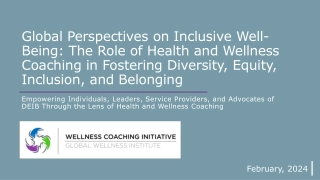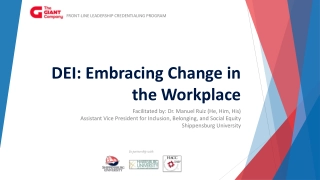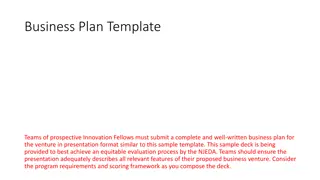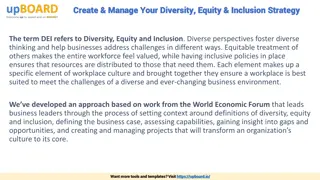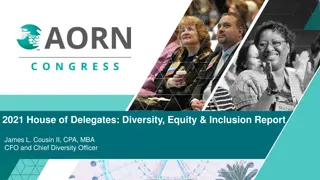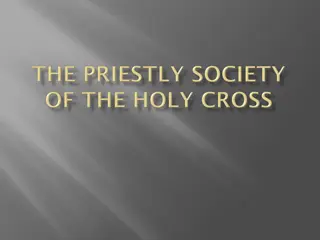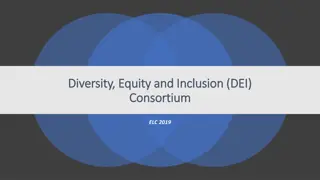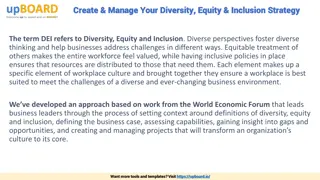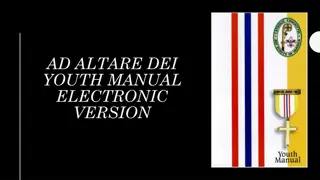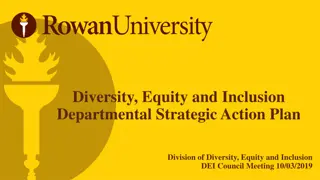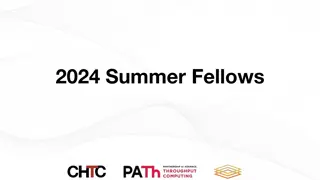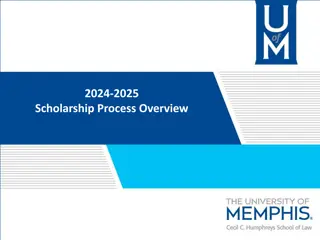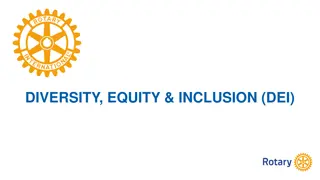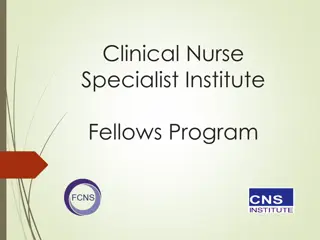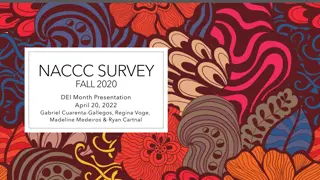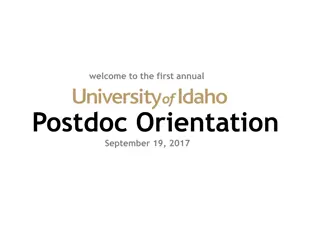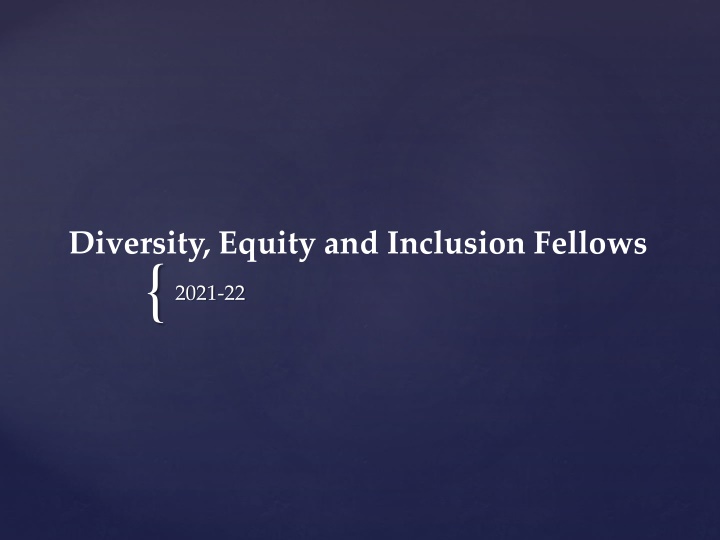
Empowering Diversity and Inclusion Initiatives in Education Leadership Programs
Explore the impactful projects of DEI Fellows for the academic year 2021-22, promoting inclusivity and equity in various educational domains like principalship courses, business schools, and creative writing classes. Witness the innovative steps taken by these fellows to enhance diversity in curriculum, teaching materials, and student experiences.
Download Presentation

Please find below an Image/Link to download the presentation.
The content on the website is provided AS IS for your information and personal use only. It may not be sold, licensed, or shared on other websites without obtaining consent from the author. If you encounter any issues during the download, it is possible that the publisher has removed the file from their server.
You are allowed to download the files provided on this website for personal or commercial use, subject to the condition that they are used lawfully. All files are the property of their respective owners.
The content on the website is provided AS IS for your information and personal use only. It may not be sold, licensed, or shared on other websites without obtaining consent from the author.
E N D
Presentation Transcript
Diversity, Equity and Inclusion Fellows { 2021-22
Paula Perez Eduardo Millet Mathew Swerdloff Aaron Ricciardi Anthony Dandridge Zachary Bowman Jennifer Russo Allison Moore Jessica Smeeks DEI Fellows 2021-2
I designed the EDA769 Principalship course to be relevant, rigorous, and relational. Students started by reflecting on their leadership style, values, and beliefs; in other words, their "why". James Childs and I facilitated an introduction to dimensions of diversity inclusive of accessibility accommodations. Assignments included developing a hiring system that mitigated bias then using it to conduct "mock" interviews with undergraduate students in the teaching program, developing a principal entry plan, and facilitating "courageous conversations" around diversity with the class and BIPOC guests. They were also exposed to panels of Black administrators - state ed rep, principals, special ed, and educational leadership consultant throughout the course. Paula Perez Educational Studies and Leadership
During my DEI Fellowship at SUNY New Paltz, I explored the importance of teaching with relevant content; especially DEI relevant. Relevance is defined as a student perception of whether the course content satisfies personal needs, personal goals, and/or career goals (Keller, 1983). My project outcome was a diagnostic matrix to evaluate if a course/department/school uses diverse materials to make the content relevant to diverse groups. Eduardo Millet School of Business
Evaluated three syllabi and texts for more inclusive resources and texts Changed two texts to represent a more diverse gender and racial perspective on issues in the course Reviewed 50% of case studies used in my courses with a focus on DEI and selected several cases to discard Began writing my own case studies that represent a wider variety of voices and that are free from bias and stereotyping Mathew Swerdloff Educational Studies and Leadership
Diversification of curriculum in Creative Writing and Craft of Playwrighting Classes Support for trans, non-binary and LGBTQ+ students, including actors/directors for plays written by the community (one of Aaron s students, Aidan Pauer, had their play, Clara and Camilla, accepted for the New York City Theater Festival). Aaron Ricciardi Department of English
Cross-curricular assessment of Black voices in curricula on campus Development of material for Rap and Spoken Word course Anthony Dandridge Department of Black Studies
Focused on two exhibitions: "Somewhere in Advance of Nowhere: Freedom Dreams in Contemporary Art," curated by Nico Wheadon and featuring contemporary artists of color and "Ben Wigfall and Communications Village," which tells the story of one of the first African American professors at SUNY New Paltz. We have engaged our audiences both virtually and in-person this semester with a range of DEI programs from academic presentations, social gatherings, and hands-on artmaking. We were happy to host another class of older adults from the Lifetime Learning Institute for Dialogs in Art which ran from April 22 to May 13. The class size of 13 people was perfect for connective conversation in the museum, providing an opportunity for these retired individuals to connect with their local peers and our exhibitions. We partnered with The Eddy New Paltz and The Faculty Development Center to host a virtual presentation by Professor Myron T. Strong, an award-winning sociologist whose research explores Afrofuturism, race, gender and other social factors in modern comics and popular culture. This event, Afrofuturism: The Imagination to Change, was extremely well attended by SUNY New Paltz students and a partnering university in South Africa. The presentation was followed up by an evening of art-making, food, and conversation in the exhibition Somewhere in Advance of Nowhere: Freedom Dreams in Contemporary Art (hosted in collaboration with the FDC and Eddy New Paltz). Students from the campus s Disability Resource Center came to tour the exhibition Mary Frank: The Observing Heart and produced paintings on bluestone of their own spirit animals This is a small selection of programming in a robust season. The museum is committed to continuing to present work by BIPOC, LGBTQIA+, older and underrepresented artists and providing members who identify with these communities in our area opportunities to engage with each other and our exhibitions. Zachary Bowman Samuel Dorsky Museum
Title IX Training for campus organizations Training in creating and facilitating DEI programs that are impactful. Jennifer Russo Center for Student Engagement
Brought together 3-4 faculty/staff from various religious and spiritual traditions and asked them to talk about relationships between faith and work (or the lack of a relationship. Planning as a result of our meetings to spend the next year meeting with existing student groups, listening, and looking for partnerships to advance that goal. At Fall Orientation, worked with Residence Life, Black Lives Matter, The Eddy, and Student Activities (Engage) to make a woven welcome tent ! Pitup a pop-up tent, with a table, some chairs, yards of ribbon and pens, and ask people to write anything they want about their identities on the ribbons. They were woven together to create one, two, three walls of the tent multiple identities woven into one community. My action, putting up the tent, supplying the materials, and finding some co-sponsors, intended to be a catalyst for anyone on the campus community to participate. Allison Moore Episcopal Campus Ministry
As a scholar that conducts research in Peru, my primary goal in becoming a DEI fellow was to find ways to make students aware that Diversity, Equity, and Inclusion are not merely an issue in the United States. Countries and people all over the world struggle with underrepresentation, marginalization, and disparities. My secondary goal was to find more ways to incorporate personal accounts and reflections of those struggling with these issues. We so often, even as DEI scholars, inadvertently place people into boxes, and most of the time people do not appreciate the boxes or agree with the labels we place upon them. To tackle these issues, the last two weeks of my Cultures of South America class focused on so-called indigenous populations across South America. We discussed how native populations in Bolivia and Columbia are promoting an indigenous identity, while native populations in Peru and Ecuador reject the term indigenous and any term that links them to former, Spanish- imposed labels. We also talked about the current manipulation and appropriation of particular "indigenous" histories (or social memories) and identities by South American governments for economic gain--a source of wealth that never trickles down to the current descendants. To emphasize the need to understand and respect personalized identities, I had students read two perspectives on the current state of "indigenous" peoples in South America, one written by a Western European scholar and one written by an Ecuadorian scholar. Without prompting, as I did not explain the origins of the authors or my intended goals ahead of time, the students began pointing out key differences between the readings and the biases of the "non-native scholar" during class discussion. They immediately recognized the importance of (1) letting people explain their own situations, feelings, and identities and (2) working alongside (vs. for) them in the fight for equity and inclusion. Jessica Smeeks Department of Anthropology
Thank you DEI Fellows! Thank you Provost Lyman! Thank you, thank you, Sarah!!!!

